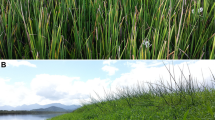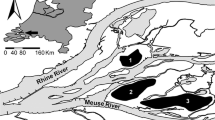Abstract
We monitored the abundance of a non-native (Rhinogobius sp. OR) and two native stream gobies (R. fluviatilis and R. nagoyae) over a decade, from 1995 to 2004, in a fixed reach of a tributary of the Kamo River, southwestern Japan. The non-native Rhinogobius sp. OR appeared and reproduced in 1997, when an increased deposition of fine sediments occurred. However, after a severe spate in 1999, the non-native goby almost completely disappeared from the study reach, while the density of the native R. fluviatilis increased. The severe spate is likely to have prevented the establishment of the non-native goby. Our results provide an example of abiotic barriers to invasion.



Similar content being viewed by others
References
Allan JD (1995) Stream ecology: structure and function of running waters. Chapman and Hall, London
Bêche LA, Connors PG, Resh VH, Merenlender AM (2009) Resilience of fishes and invertebrates to prolonged drought in two California streams. Ecography 32:778–788
Blair TC, McPherson JG (1999) Grain-size and textural classification of coarse sedimentary particles. J Sediment Res 69:6–19
Cucherousset J, Olden JD (2011) Ecological impact of non-native freshwater fishes. Fisheries 36:215–230
Fausch KD, Taniguchi Y, Nakano S, Grossman GD, Townsend C (2001) Flood disturbance regimes influence rainbow trout invasion success among five Holarctic regions. Ecol Appl 11:1438–1455
Harada M, Kayaba Y (2015) Perspectives on the hydraulic and ecological studies on the role of riverbed in the upper and middle reaches. Ecol Civil Eng 18:3–18 (in Japanese with English abstract)
Ito S, Koike H, Omori K, Inoue M (2006) Comparison of current-velocity tolerance among six stream gobies of the genus Rhinogobius. Ichthyol Res 53:301–305
Itsukushima R, Sato T, Nishida K, Masago Y, Sakata T, Shimatani Y (2017) Development of channel organization and roughness following sediment pulses in single-thread, gravel bed rivers. Ecol Civil Eng 19:165–180 (in Japanese with English abstract)
Jordan DS, Seale A (1906) Descriptions of six new species of fishes from Japan. Proc U S Natl Mus 30:143–148
Leprieur F, Hickey MA, Arbuckle CJ, Closs GP, Brosse S, Townsend CR (2006) Hydrological disturbance benefits a native fish at the expense of an exotic fish. J Appl Ecol 43:930–939
Madej MA (2001) Development of channel organization and roughness following sediment pulses in single-thread, gravel-bed rivers. Water Resour Res 37:2259–2272
Marchetti M, Moyle PB (2001) Effects of flow regime on fish assemblages in a regulated California stream. Ecol Appl 11:530–539
Mizuno N (1989) Rhinogobius sp. CB and LD. In Kawanabe H, Mizuno N (eds) Freshwater Fishes of Japan. Yama-to-Keikokusha, Tokyo, pp 587–591 (in Japanese)
Moyle PB, Light T (1996) Fish invasions in California: do abiotic factors determine success? Ecology 77:1666–1670
Okuda N, Ito S, Iwao H (2002) Female spawning strategy in Rhinogobius sp. OR: how do women deposit their eggs in the nest? Ichthyol Res 49:371–379
Tanaka S (1925) Figures and descriptions of the fishes of Japan including Riukiu Islands, Bonin Islands, Formosa, Kurile Islands, Korea and southern Sakhalin. Figures and Descriptions of the Fishes of Japan 34:629–644 (in Japanese and English)
Acknowledgements
We would like to thank Okuda N, Yanagisawa Y for discussion, Shimizu T and Mizuno N for helpful information and advice, Matsuhana M and Ito M for assistance during data collection, and Kudo S, Kudo T, Miura M, Matsumoto K and other members of the Kamogawa Fishermen’s Union for providing their facilities and kindness. This study was supported by the River Environment Fund (REF: 16-1-(4)-33) in charge of the Foundation of River and Watershed Environment Management (FOREM), Japan, and by grants from the 21st Century COE program of the Center for Marine Environmental Studies, Ehime University, Japan.
Author information
Authors and Affiliations
Corresponding author
Additional information
Publisher's Note
Springer Nature remains neutral with regard to jurisdictional claims in published maps and institutional affiliations.
Supplementary Information
Below is the link to the electronic supplementary material.
10228_2021_819_MOESM1_ESM.pptx
Supplementary file1. S1 Location map of the study reach. The star indicates the study site. S2 Maximum daily (column) and total (solid circle) precipitation during the rainy season (June and July) from 1995 to 2004. Data are from the ‘Jyojyusha’ meteorological station (Japan Meteorological Agency), located at the head water catchment of the Kamo River (PPTX 1164 KB)
About this article
Cite this article
Ito, S., Tamura, Y., Sato, A. et al. Occurrence and disappearance of a non-native goby Rhinogobius sp. OR in relation to hydrological conditions in the Kamo River, southwestern Japan. Ichthyol Res 69, 176–181 (2022). https://doi.org/10.1007/s10228-021-00819-0
Received:
Revised:
Accepted:
Published:
Issue Date:
DOI: https://doi.org/10.1007/s10228-021-00819-0




